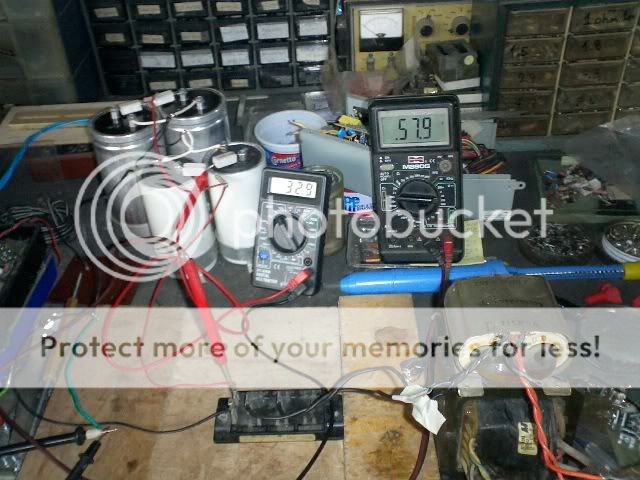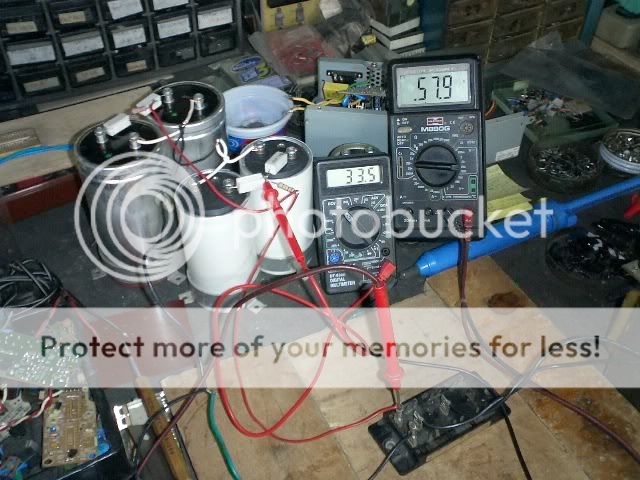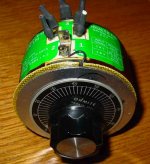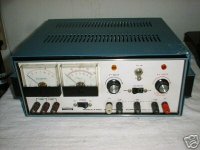Hi,
----------------
Note: Before posting this thread I did a search and found a couple of posts which mentioned the use of a "variac." I don't have such equipment, and my question is a bit more specific. (Please read)
---------------
I bought a pair of Heathkit AA-13 Mono Amps. They need new capacitors, so I bought new stock with the exception of two, which are NOS ("New Old Stock").
The NOS is a 40-40-20 Twist Prong Capacitor which I feel very lucky to have found. I was about to give up and try rebuilding my old Twist Prong Caps with new Electrolytic "guts." Then I stumbled onto a web site in Nebraska that listed the very part I needed. They are the only place on Earth that had them (unless I just don't know where to look). The original stock was 40-40-20 at 350 volts (at 40 ohms) and 450 volts (at 20 ohms). The new Twist Prong caps are rated at 500 volts at all three terminals.
Anyway, while reading about replacing Electrolytic Capacitors, I read a couple of articles about the need to "reform" them if they have been sitting idle for any length of time; (which some define as little as 6 months).
Does anyone know the truth regarding the matter? Also, is there an easy way to do it? I don't have the kind of equipment necessary to produce 500 volts. It's just me, my soldering iron, and my multimeter. (I ain't got no steenking "variac"!)
I need to know if I am going to ruin these rather expensive capacitors ($25 bucks) if I install them without "reforming" them. If "reforming" *is* necessary, is there an "easy" way of doing it? For example, I read an article about reforming the quad caps in a Dynakit Mark III which involved removing the rectifier tube, removing the red wire and replacing the red wire with a 100k resistor, then plugging in the unit and using IT'S OWN JUICE to do the "reforming."
Doing it without a "variac" or other equipment is specifically what I am asking.
Thanks in advance...
smiles,

Gregg
----------------
Note: Before posting this thread I did a search and found a couple of posts which mentioned the use of a "variac." I don't have such equipment, and my question is a bit more specific. (Please read)
---------------
I bought a pair of Heathkit AA-13 Mono Amps. They need new capacitors, so I bought new stock with the exception of two, which are NOS ("New Old Stock").
The NOS is a 40-40-20 Twist Prong Capacitor which I feel very lucky to have found. I was about to give up and try rebuilding my old Twist Prong Caps with new Electrolytic "guts." Then I stumbled onto a web site in Nebraska that listed the very part I needed. They are the only place on Earth that had them (unless I just don't know where to look). The original stock was 40-40-20 at 350 volts (at 40 ohms) and 450 volts (at 20 ohms). The new Twist Prong caps are rated at 500 volts at all three terminals.
Anyway, while reading about replacing Electrolytic Capacitors, I read a couple of articles about the need to "reform" them if they have been sitting idle for any length of time; (which some define as little as 6 months).
Does anyone know the truth regarding the matter? Also, is there an easy way to do it? I don't have the kind of equipment necessary to produce 500 volts. It's just me, my soldering iron, and my multimeter. (I ain't got no steenking "variac"!)
I need to know if I am going to ruin these rather expensive capacitors ($25 bucks) if I install them without "reforming" them. If "reforming" *is* necessary, is there an "easy" way of doing it? For example, I read an article about reforming the quad caps in a Dynakit Mark III which involved removing the rectifier tube, removing the red wire and replacing the red wire with a 100k resistor, then plugging in the unit and using IT'S OWN JUICE to do the "reforming."
Doing it without a "variac" or other equipment is specifically what I am asking.
Thanks in advance...
smiles,
Gregg
-------------------Tony said:yes, if the NOS caps have slept on the shelf for years! i would not risk a big bang, i will reform!
Hi Tony,
The other half of my question was how to do it without equipment like a variac? Is there a way to do it similar to the method I stated for use with the Dynakit Mark III?
Thanks,
Gregg
Hi Gregg,
Reforming is absolutely necessary with NOS caps. Even then, they may not be good. Often, the electrolyte dries out and the cap is less than useless. You have no idea how many cans I've emptied and installed new units inside.
Pinkmouse has listed a good web site, the information is correct. I leave them forming much longer. Then I discharge them and measure the capacitance and dissipation factor. Where possible, buy new capacitors.
I see Tony has reformed (to what?? )
)
So you need an adjustable HV power supply and a resistor as stated on the site pinkmouse linked to. A variac is the least expensive way to do this. I use a regulated power supply as it's the easiest way. You get to use your meter. Watch the measurement across the resistor as it is at the high potential. Make sure there are no children or strangers that can startle you, or my favorite - what's this ? POW. Please be careful. Also, do this in the chassis. At least the caps aren't rolling around free and there is some protection from touching the terminals.
I Like SS rectifiers for this because the tube type don't get going until the voltage is up there. To drop the AC line voltage, you could run a light bulb in series and another in parallel to make a voltage divider. Vari the wattage ratios to control the voltage.
-Chris
Reforming is absolutely necessary with NOS caps. Even then, they may not be good. Often, the electrolyte dries out and the cap is less than useless. You have no idea how many cans I've emptied and installed new units inside.
Pinkmouse has listed a good web site, the information is correct. I leave them forming much longer. Then I discharge them and measure the capacitance and dissipation factor. Where possible, buy new capacitors.
I see Tony has reformed (to what??
So you need an adjustable HV power supply and a resistor as stated on the site pinkmouse linked to. A variac is the least expensive way to do this. I use a regulated power supply as it's the easiest way. You get to use your meter. Watch the measurement across the resistor as it is at the high potential. Make sure there are no children or strangers that can startle you, or my favorite - what's this ? POW. Please be careful. Also, do this in the chassis. At least the caps aren't rolling around free and there is some protection from touching the terminals.
I Like SS rectifiers for this because the tube type don't get going until the voltage is up there. To drop the AC line voltage, you could run a light bulb in series and another in parallel to make a voltage divider. Vari the wattage ratios to control the voltage.
-Chris
It looks to me like people do this (mostly) to capacitors that are much bigger than the 40uf I'm working with.
Not only that, but when I look at the prices on variable transformers in the 500 volt range (with most having an output max of 240 volts), it would be MUCH MUCH MUCH MUCH MUCH cheaper for me to just open the can and simply rebuild the twist prong cap with brand new electrolytics.
I found this site which is very helpful:
http://www.nmr.mgh.harvard.edu/~reese/electrolytics/index.html
Thanks everyone...
smiles,

Gregg
Not only that, but when I look at the prices on variable transformers in the 500 volt range (with most having an output max of 240 volts), it would be MUCH MUCH MUCH MUCH MUCH cheaper for me to just open the can and simply rebuild the twist prong cap with brand new electrolytics.
I found this site which is very helpful:
http://www.nmr.mgh.harvard.edu/~reese/electrolytics/index.html
Thanks everyone...
smiles,
Gregg
Hi Gregg,
You need to look at the CV product (capacitance X voltage) to get an idea of "size". I would probably not reform a large, low voltage capacitor. There are replacements available.
Old can type like yours are a different story. Firstly, the unit should be powered up to assess it. What you want to do is avoid damaging any parts. To do this, the capacitors need to be reformed and replaced if they have failed. This will allow you to see what needs to be done, even if the caps sort of work. At least you will not need to purchase a bunch of caps (possibly resistors or rectifier tube). If the unit is simply powered up, the power transformer may be damaged. End of unit.
So you can see there is good reason to follow some procedure for reforming the caps. What I would do is get a variac and temporarily tack some silicon diodes (or make a circuit with clip leads). You can then use the existing power transformer to generate the higher voltages. Yes, the first time it will cost some money. You will however use this over the years making checking these caps a lot easier. Because all the caps are in circuit, you need to troubleshoot which cap is drawing current. That is simple.
Remember, on a multiple section capacitor, if one unit is bad the entire can should be replaced as the other sections will also fail later.
-Chris
You need to look at the CV product (capacitance X voltage) to get an idea of "size". I would probably not reform a large, low voltage capacitor. There are replacements available.
Old can type like yours are a different story. Firstly, the unit should be powered up to assess it. What you want to do is avoid damaging any parts. To do this, the capacitors need to be reformed and replaced if they have failed. This will allow you to see what needs to be done, even if the caps sort of work. At least you will not need to purchase a bunch of caps (possibly resistors or rectifier tube). If the unit is simply powered up, the power transformer may be damaged. End of unit.
So you can see there is good reason to follow some procedure for reforming the caps. What I would do is get a variac and temporarily tack some silicon diodes (or make a circuit with clip leads). You can then use the existing power transformer to generate the higher voltages. Yes, the first time it will cost some money. You will however use this over the years making checking these caps a lot easier. Because all the caps are in circuit, you need to troubleshoot which cap is drawing current. That is simple.
Remember, on a multiple section capacitor, if one unit is bad the entire can should be replaced as the other sections will also fail later.
-Chris
-------------------------anatech said:...Yes, the first time it will cost some money. You will however use this over the years making checking these caps a lot easier...
-Chris
Hi Chris,
Okay, I understand.
I know where I can get my hands on a DC generator that goes as high as 400 volts DC. From what I am reading, that is essentially what I need. The "variacs" I keep finding at have *AC* output.
Or am I not looking for the right equipment? (i.e. - When I use the search word "variac" I keep finding variable output AC transformers).
Under the search word "variac" (or "variable transformer"), I am finding variable transformers that are suited towards providing AC current for older tube equipment "back in the day" when AC current *really was* about 110 volts, whereas today's current is more like 125-130 volts. (My wall socket reads 125)
Obviously the word "variac" is sending me in the wrong direction for what I am trying to do; (i.e - "reform" capacitors using high voltage DC current).
Yes, no? (I'm an idiot and should give it up? or what?)
Thanks,
Gregg
Hi Gregg,
Yes, a Variac is just a variable output AC transformer. 0~125 VAC is common. You would then plug the equipment into this and use silicon diodes to generate the required DC voltage.
The variac will also be very useful for servicing solid state equipment to avoid damage, or at least reduce the chance of added damage. So the variac is a multi purpose device. Very useful.
-Chris
Yes, a Variac is just a variable output AC transformer. 0~125 VAC is common. You would then plug the equipment into this and use silicon diodes to generate the required DC voltage.
The variac will also be very useful for servicing solid state equipment to avoid damage, or at least reduce the chance of added damage. So the variac is a multi purpose device. Very useful.
-Chris
Hi Chris,anatech said:...You would then plug the equipment into this and use silicon diodes to generate the required DC voltage...
So what would the circuit look like to generate 500 volts? (Give or take because all of the instructions I read say the voltage accuracy is not critical, as long as it is less rather than more).
Can you draw (or describe) a block diagram? A schematic is going to mess with me. (Sorry). However, I'll take it anyway you can offer it. I bought a book on reading schematics, but haven't gotten it yet. What I really need is a constant reminder of what the symbols are. If I had that for reference at all times I'd be somewhat more competent to understand schematics.
I just bought a 0-130 volt variac for $5 bucks on ebay. This was *significantly* cheaper than everyone else, and it was a "Buy It Now" sale. The only down side was a lower output amperage than some of the others. This one has an output amperage of 1.75. That seems like enough for what I'm doing, (yes, no?). If not, I can resell it or use it for some other project.
I've attached a photo of it.
Thanks,
Gregg
Attachments
If I were in your position, I'd fit the NOS capacitors, then isolate the PSU from the rest of the amp. Power up, with a 15W lamp in series with the mains supply. The lamp will glow brightly at first, then dim as the caps charge. Switch on and off a couple of times until the dimming is smooth and fairly fast, then repeat with a larger lamp. Same again with a bigger one, by which time the caps should be reformed (or the lamps would have refused to dim, indicating U/S caps).
Reconnect the PSU, and repeat the process, listening for hum on the output - if there's much noise, switch off straight away
Much quicker in practice than it sounds
Whichever way you do it, make sure that there's a solid guard of some sort between the caps and you, check their temperature after each test, and discharge before handling
Reconnect the PSU, and repeat the process, listening for hum on the output - if there's much noise, switch off straight away

Much quicker in practice than it sounds
Whichever way you do it, make sure that there's a solid guard of some sort between the caps and you, check their temperature after each test, and discharge before handling

Okay Guys,
I've got a "what would you do?" question to add to the mix:
I went ahead and installed all of the *new* Electrolytic Caps that I bought. I did this to both of my Healthkit AA-13 amps. Keep in mind that I bought these amps on ebay, and they were sold as "working" but were sold as parts units for their (supposedly) valuable transformers.
I've got a soft spot for Heathkit and just HAD TO save these babies. When I got them they both did work, but they would both lose volume after about a half hour of use. That was why I bought the new caps, which quite frankly I would have done anyway. I know it's better to replace the easy stuff BEFORE it goes bad and takes out the expensive stuff.
What I'd like to know is whether or not I really need to replace those Twist Prong Caps? I now have TWO problems with them. Besides the fact that they are NOS and therefore need to be reformed, it turns out they are TALLER which means I would have to mount them on their sides which will REALLY LOOK DUMB.
My other alternative is to buy three separate capacitors and wire them separately under the unit, leaving the old Twist Prong in place, but not wired up. That's probably the way I would go, if I do it.
The reason I am thinking twice about even replacing them at all is because it appears I don't need them.
These amps have been playing flawlessly now for about 4 hours, and they both sound perfect. They have identical volume, identical tone, etc... It's easy to know they are "right" when you've got two of them to compare with each other. (Even the filter balance setting wound up in the same spot after I adjusted them).
So, the question is: "DO I NEED TO REPLACE THESE CAPS, WHICH ARE WORKING PERFECTLY?"
By the way, I won a Heathtkit SP-2717A Regulated HV Power Supply on ebay for $56 bucks (sold "as is" of course). I figure it is worth it for me to spend the extra cash on a DC regulated power supply, rather than messing with variacs and diodes and blowing stuff up because I really don't know what I'm doing with them. I've got the manual for it; (I found it posted online *prior* to bidding on it). So, just in case anything is wrong with it (or goes wrong with it), I will be able to repair it.
You guys have convinced me that "reforming" old stock high voltage capacitors is a must, so I might a well have the right equipment so I can feel confident that I am doing it competently. This is turning into a serious hobby for me. I am now on my fourth stereo repair and now it's in my blood again; (I used to mess with this stuff 25+ years ago). Like I said, I might as well have the equipment to do it right; (a tip I picked up from Chris).
Back to the main point: "Should I leave those last three caps (in that Twist Prong) alone, since everything is perfect? Or should I worry about them?"
(Ps... I've attached a photo of the Heathkit SP-2717A DC Power supply I just bought).
Thanks,

Gregg
I've got a "what would you do?" question to add to the mix:
I went ahead and installed all of the *new* Electrolytic Caps that I bought. I did this to both of my Healthkit AA-13 amps. Keep in mind that I bought these amps on ebay, and they were sold as "working" but were sold as parts units for their (supposedly) valuable transformers.
I've got a soft spot for Heathkit and just HAD TO save these babies. When I got them they both did work, but they would both lose volume after about a half hour of use. That was why I bought the new caps, which quite frankly I would have done anyway. I know it's better to replace the easy stuff BEFORE it goes bad and takes out the expensive stuff.
What I'd like to know is whether or not I really need to replace those Twist Prong Caps? I now have TWO problems with them. Besides the fact that they are NOS and therefore need to be reformed, it turns out they are TALLER which means I would have to mount them on their sides which will REALLY LOOK DUMB.
My other alternative is to buy three separate capacitors and wire them separately under the unit, leaving the old Twist Prong in place, but not wired up. That's probably the way I would go, if I do it.
The reason I am thinking twice about even replacing them at all is because it appears I don't need them.
These amps have been playing flawlessly now for about 4 hours, and they both sound perfect. They have identical volume, identical tone, etc... It's easy to know they are "right" when you've got two of them to compare with each other. (Even the filter balance setting wound up in the same spot after I adjusted them).
So, the question is: "DO I NEED TO REPLACE THESE CAPS, WHICH ARE WORKING PERFECTLY?"
By the way, I won a Heathtkit SP-2717A Regulated HV Power Supply on ebay for $56 bucks (sold "as is" of course). I figure it is worth it for me to spend the extra cash on a DC regulated power supply, rather than messing with variacs and diodes and blowing stuff up because I really don't know what I'm doing with them. I've got the manual for it; (I found it posted online *prior* to bidding on it). So, just in case anything is wrong with it (or goes wrong with it), I will be able to repair it.
You guys have convinced me that "reforming" old stock high voltage capacitors is a must, so I might a well have the right equipment so I can feel confident that I am doing it competently. This is turning into a serious hobby for me. I am now on my fourth stereo repair and now it's in my blood again; (I used to mess with this stuff 25+ years ago). Like I said, I might as well have the equipment to do it right; (a tip I picked up from Chris).
Back to the main point: "Should I leave those last three caps (in that Twist Prong) alone, since everything is perfect? Or should I worry about them?"
(Ps... I've attached a photo of the Heathkit SP-2717A DC Power supply I just bought).
Thanks,
Gregg
Attachments
Hi Gregg,
Well, you pre-empted the post I was going to make.
Looks like a good supply, I use a Heathkit PS-3. I like rebuilding test gear too. I think it will serve you well.
Now to your question. Yes, I would reform those caps. If they reform well, just use them. If not, they need replacing. Look at Antique in Texas for replacements too. You can also hollow out the originals and put newer types inside. I guess you've reformed them by running the amps. Just check they aren't getting too warm (sign of leakage). Another sign is excessive voltage drop across the supply resistors.
-Chris
Well, you pre-empted the post I was going to make.
Looks like a good supply, I use a Heathkit PS-3. I like rebuilding test gear too. I think it will serve you well.
Now to your question. Yes, I would reform those caps. If they reform well, just use them. If not, they need replacing. Look at Antique in Texas for replacements too. You can also hollow out the originals and put newer types inside. I guess you've reformed them by running the amps. Just check they aren't getting too warm (sign of leakage). Another sign is excessive voltage drop across the supply resistors.
-Chris
- Status
- This old topic is closed. If you want to reopen this topic, contact a moderator using the "Report Post" button.
- Home
- Design & Build
- Parts
- Is "reforming" Electrolytic Capacitors necessary?




